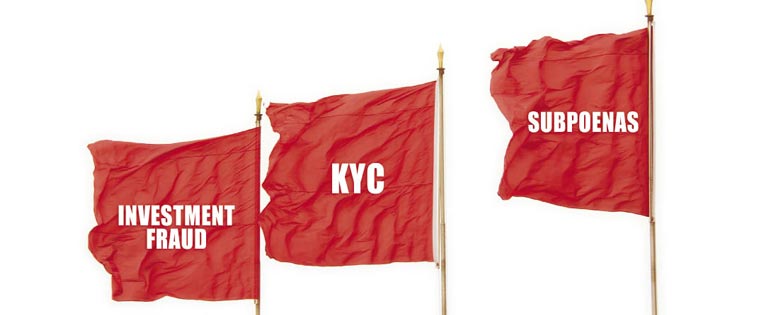
During the last several years, a number of multi-billion-dollar Ponzi schemes were uncovered and rocked the financial world. Bernie Madoff ($65 billion fraud), and Allen Stanford ($8 billion fraud), victimized thousands of people, as well as companies, who invested their money with them.
But what about the banks who banked them? There are several real life cases where banks got into legal trouble for allowing a Ponzi scheme to be conducted through its accounts. What are the red flags that a Ponzi scheme exists in a bank account? What should a bank do when confronted with these warnings indicating that a customer might be operating a Ponzi scheme? In both the Madoff and Stanford cases, the investors have sued the banks that provided services to Madoff's and Stanford's businesses. What can be learned from these and other cases? Here are three tips to stay out of trouble.
What is a Ponzi scheme?
A Ponzi scheme is a fraudulent investment operation that pays returns to investors not from actual profits earned by the firm, but from their own money or money received from subsequent investors. Ponzi schemes and pyramid schemes are closely related. They both involve paying longer standing members with money from newer members, instead of actual profits from investing or selling products to the public. But, there are also several differences. Chart 1 explains some of them.
Tips for Banks to Stay Out of Trouble
Here are three tips for banks to stay out of trouble with Ponzi scammers:
- Incorporate Red Flags of Investment Fraud into your Compliance Program
It is important to monitor the account for suspicious activity. Is there activity that is unusual? Activity that bears no resemblance to the normal patterns of a brokerage house or an investment management firm? Sometimes, the flow of money between the investment firm's account and other customers' accounts should set off warning bells.
Chart 1. Pyramid Scheme Ponzi Scheme "Hook" to bring in participants Earn profits by making one payment and finding others to become distributors of a product. The scheme typically does not involve a genuine product. The product may not exist or it is only "sold" within the pyramid scheme. Earn high investment returns with little or no risk by handing over your money; the investment typically does not exist. Payments/profits Must recruit new distributors to receive payments. No recruiting necessary. Interaction with original promoter Sometimes none. New participants may enter scheme at a different level. Promoter generally acts directly with all participants. Source of payments From new participants — always disclosed. From new participants — never disclosed. Collapse Fast. An exponential increase in the number of participants is required at each level of the scheme. May be relatively slow as long as existing participants reinvest money. Here are some red flags for Ponzi schemes that can be incorporated into the BSA/AML compliance program:
Lack of transparency and repetitive transactions: In the lawsuit against JP Morgan Chase that was unsealed by the judge in early February 2011, the plaintiffs alleged that Madoff's account frequently engaged in repeated transactions with the same parties, with no obvious purpose. For example: In 2002, Madoff's account showed an outgoing transaction to a particular customer that occurred 318 times. Each transaction was always in the exact amount of $986,301 and often multiple times per day. They also claimed that there were many repetitive transactions that had no net impact on the account. So the total monthly amounts going in were almost always equal to the total monthly dollar amounts going out.
What is the economic purpose of these transactions? Cases like this teach us that when you see these red flags, it is important to act on your suspicions. The Bank Secrecy Act and related regulations impose a duty on the bank to file a Suspicious Activity Report (SAR). The activity that triggers the SAR is not always as obvious as drug trafficking. It can be fraud as well. The SAR form for depository institutions particularly mentions several frauds in the list of "summary characterizations of suspicious activity." They include: Credit card, debit card, check, loan and wire transfer fraud. Ponzi schemes or an investment fraud are not mentioned, but nothing stops you from just marking "other."
- Conduct KYC on your Investment Firm Clients
A sound Know Your Customer program is key to any anti-money laundering program, conducting Customer Due Diligence on your investment firm clients is essential. When a business is "too good to be true," it is time to take a closer look at the client. AmSouth Bank from Alabama learned to their chagrin that banking a customer who turned out to be operating a Ponzi scheme can spell disaster. Not only for the victim investors, but also for the bank. In this 2004 case, two of the bank's customers, Nance and Hamrick, ran a Ponzi scheme. Nance had been a financial advisor for years and convinced many of his clients that they should invest in a "promissory note" with Hamric. The promissory notes were held in an AmSouth account that had been established for each victim. As always in Ponzi schemes, the promised interest was pretty high. Some of the notes promised interest of up to 25 percent monthly. This should have been a red flag for the bank. The victims were told that they were investing in a money trading program, but no such program existed. The interest they received was, in fact, a repayment from their own funds. Prosecutors and regulators believed that the bank had a duty to flag the transactions and file suspicious activity reports in response. In the Hamric case, only one SAR was filed by AmSouth and it was filed two years after the suspicious activity occurred. The filing mischaracterized the activity as check fraud and understated the amount involved.
Also, check whether the investment is registered. Ponzi schemes often involve investments that have not been registered with the U.S. Securities and Exchange Commission or with state regulators. Registration is important because it provides investors with access to important information about the company's owners, management, products, services and finances. Also, be aware of unlicensed parties. Federal and state laws require investment professionals or firms to be licensed. Many Ponzi schemes involve unlicensed individuals or unregistered firms. Attendance by bank representatives at investor meetings where misrepresentations as to your bank's role were made can also be dangerous. Speak up or document your disagreement. If not, this can be used against the bank later. One last tip on KYC: Larger banks typically use due diligence teams that visit the feeder funds. Make sure that the risk management or AML committee receives information from these teams. Do not continue to provide banking services to the firm after your bank conducted due diligence on its operations and decided to liquidate the bank's own position in firm's investment funds. That just does not bode well in the courtroom.
- Do Not Ignore Subpoenas
It is also key to act on important negative information, such as discovery of prior criminal history of a company principal, litigation accusing the company of wrongdoing or regulatory enforcement activity concerning the client. AmSouth did not flag the clients' account involved in a $129 million fraud scheme even after they were arrested, media coverage began and the bank received eight subpoenas from a federal grand jury related to the Hamric and Nance accounts (see chart below). Information that was subpoenaed included documents for bank accounts held by the fraudsters; documents for any custodial trust accounts opened by them on behalf of other account holders; and communications between any AmSouth employee and Hamric, Nance or any custodial trust account holder. According to the court documents, here are some of the bank missteps in response to these grand jury subpoenas.
- The bank did not timely produce documents called for by these subpoenas.
- The bank did not produce certain documents until the bank itself was targeted in the criminal investigation.
- The bank did not produce documents in the manner they were kept in the regular course of business as required by the subpoenas.
- Outside counsel assumed wrongly that certain documents had already been produced.
- Inside counsel failed to search his own files, and did not request documents from other employees.
In the end, the bank received a civil money penalty and a deferred prosecution agreement involving $50 million in 2004. The Ponzi investigation triggered a wider review of the bank's BSA/AML program by the regulators. In addition, the severe monetary penalties delayed the bank's ambitious expansion plan to open dozens of new branches because the authorities restricted the bank's expansion activities until AmSouth complied with AML laws.
Conclusion
As a bank, you have legal duties to investigate whether your clients are laundering ill-gotten gains. If you do not, you will join the cadre of banks that got into trouble. Not only will your bank be subject to actions from the banking regulators, and forfeiture actions from the Department of Justice, but also to multi-billion dollar lawsuits in which plaintiffs will try to prove that the bank knew or should have known that it was raking in money from a Ponzi scheme. Banks cannot just ignore these duties.











